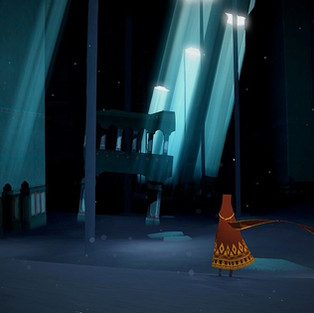What's going on everyone?
A couple of years ago, a colleague of mine who teaches ELA constantly expressed how much he likes to teach a unit on The Hero's Journey; an archetypal story pattern where a character embarks, often reluctantly, on an adventure. The character overcomes a conflict and eventually returns home with a better understanding of the world they live in. I remember him using stories like The Hobbit, The Hunger Games, or Harry Potter. I wish I had played Journey by thatgamecompany earlier so that I could have recommend using this game. You can find the lesson plan for Journey here.

Journey is a very simple story. A robed figure departs on an adventure to reach the top of a mountain. The journey will not be an easy one but in the end, the robed figure returns with more knowledge of the world. It does all of this without saying a word. The game communicates through its visuals as there is zero dialogue. Journey is a great game to teach The Hero’s Journey. Not everyone will agree whether or not the robed figure is a hero, but it will force the students to focus more on the protagonist’s literal actions since the robed figure never really speaks with another character.
Joseph Campbell, an American mythological researcher, broke The Hero's Journey into three acts; departure, initiation, and return. Within those three acts are seventeen stages. I am not going speak at length now about how Journey touches upon all seventeen stages. If that is an interest to you, there is a great write up over at AmbiGamingCorner. They do a wonderful job of providing an in depth analysis of each stage of The Hero's Journey as portrayed in the game. Let's instead talk about why this game will be great for the classroom.
The robed figure may not seem like the heroic type when the game starts, but as you progress it becomes clear that this character is one of the archetypal heroes. Christopher Reeve defined being a hero as "an ordinary individual who finds the strength to persevere and endure in spite of overwhelming obstacles.” A hero does not need to be a superhero, or savior. As Joseph Campbell puts it, “a hero is someone who has given his or her life to something bigger than oneself.”
This game is a one of a kind. It is broken up into eight distinct sections with a playtime of a little under three hours. Like many other games on this site, there is zero spoken dialogue. I choose games like this because it is more accessible to my students, whom are all English Language Learners. Journey focuses solely on visuals and sound to tell this story. And it does so majestically. To say this game is beautiful is an understatement.
The moments in between the eight levels are opportune moments to have discussion about the narrative. These are also ideal times to switch out which student is currently playing. Students who are not playing are going to remain engaged because the game is such a treat to look at and listen to. As a game, it is simple, but as a story, has complex details- but not in a way that is difficult to understand. It is complex in that it gets the players to think about this world and want to learn more. It makes you feel for a character who does not speak and whose face you never see.
I think this game would best be taught after having already taught a traditional text. This can help lay the foundation for an understanding of The Hero's Journey. Playing this game afterwards will absolutely help cement that understanding and get students thinking critically about what it actually means to be a "hero."

I always advocate for the story telling capabilities of video games and how they would fit right at home in ELA classes. How many of us have used movies as a part of our curriculum? Games like Journey can serve the same purpose. It is not just a great game. It is a work of art which just may be what you need to get some of your students interested in literature.
Thanks for reading,
Zack







Comments